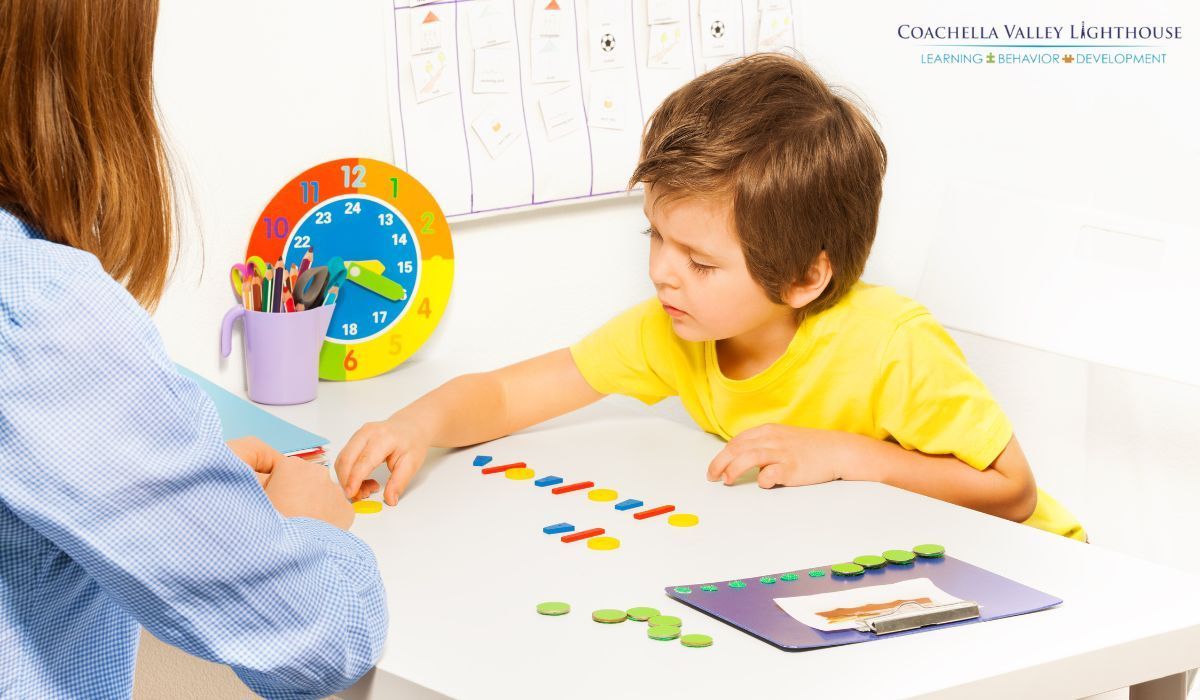By Christine Kent
•
September 2, 2024
Effective communication is fundamental to building relationships, understanding the world, and expressing one’s needs and desires. However, for children with autism spectrum disorder (ASD), communication can often be challenging. These children may struggle with speech, language comprehension, social cues, or non-verbal forms of communication. Applied Behavior Analysis (ABA) therapy has proven to be one of the most effective interventions in helping children with autism improve their communication skills, significantly enhancing their ability to interact with others. In this blog post, we will explore the profound impact of ABA therapy on communication skills, explain the various techniques used, and highlight the success stories of many children who have benefited from this evidence-based approach. If you're a parent looking for ways to help your child better communicate, understanding how ABA therapy can aid in this developmental area may be crucial for your child's progress. Understanding Communication Challenges in Children with Autism Children with autism may face a variety of communication challenges. These challenges can vary significantly from child to child and depend on the severity of their autism symptoms. Some children may be completely non-verbal, while others may have delayed speech or difficulty with the social aspects of communication, such as understanding body language or maintaining eye contact. The main communication challenges experienced by children with autism often include: Delayed speech or language development: Some children may not begin to speak until much later than their peers or may have a limited vocabulary. Difficulty with social communication: Children with autism may struggle to engage in typical social interactions, including starting or maintaining a conversation, understanding social cues, or reading the emotions of others. Echolalia: This is the repetition of words or phrases that the child hears, often without understanding their meaning. While it may seem like the child is speaking, they may not be using these words functionally or communicatively. Non-verbal communication issues: Many children with autism find it difficult to use or interpret non-verbal communication, such as gestures, facial expressions, or body language. Limited joint attention: Joint attention, the ability to share focus on something with another person, is a key part of communication that may be challenging for children with autism. ABA therapy specifically targets these challenges through individualized, structured interventions that help children develop the communication skills they need to express themselves effectively. The Role of ABA Therapy in Communication Development ABA therapy is a widely accepted and scientifically supported form of therapy that focuses on behavior modification to teach new skills and reduce behaviors that interfere with learning and social interaction. One of the primary goals of ABA therapy is to help children with autism improve their communication skills, whether through verbal or non-verbal means. Here’s how ABA therapy supports communication development: Individualized Therapy Plans: ABA therapy begins with a comprehensive assessment of the child’s communication abilities, followed by the development of a personalized therapy plan. This plan is tailored to the child’s specific needs and communication goals. The therapy plan focuses on breaking down complex communication skills into smaller, more manageable steps. By teaching these skills incrementally, ABA therapists can help children with autism learn at their own pace. Positive Reinforcement: One of the core principles of ABA therapy is the use of positive reinforcement. Positive reinforcement involves rewarding the child for demonstrating desired behaviors, such as making a request or using appropriate language. This reward system helps the child understand that effective communication leads to positive outcomes, encouraging them to use the communication skills they are learning. For example, if a child successfully uses a word to ask for a toy, they may receive praise or a tangible reward, reinforcing that behavior. Verbal Behavior Therapy (VBT): Verbal Behavior Therapy, a subfield of ABA, specifically focuses on teaching children how to use language functionally. VBT breaks language down into different categories, known as “operants,” including: Mands: Requests made by the child (e.g., asking for a toy). Tacts: Labels or descriptions of things in the environment (e.g., pointing out a car). Echoics: Imitation of sounds or words (e.g., repeating a word spoken by a therapist). Intraverbals: Responses to questions or conversations (e.g., answering “What’s your name?”). Autoclitics: More complex, higher-level forms of language that modify or clarify meaning. By teaching language in these specific categories, ABA therapists can help children develop functional communication skills that are meaningful in their everyday lives. Augmentative and Alternative Communication (AAC): For children who are non-verbal or have limited verbal communication, ABA therapy can incorporate the use of AAC devices or systems. AAC includes any form of communication that supplements or replaces speech, such as: Picture Exchange Communication System (PECS): Children use pictures to communicate their needs or desires by exchanging a picture with the therapist or parent. Speech-generating devices (SGDs): These devices allow children to press buttons to produce words or phrases, enabling them to communicate even if they cannot speak verbally. ABA therapists work closely with children to introduce and teach the use of AAC systems, allowing them to communicate effectively and independently. Prompting and Fading: In ABA therapy, therapists often use prompts to help children learn new communication skills. A prompt is a cue or instruction given to the child to encourage a desired behavior. For example, if a child is learning to say “water” when they’re thirsty, the therapist might initially model the word or gesture the child should use. Over time, the therapist gradually fades the prompt, encouraging the child to use the communication skill independently. Modeling and Imitation: ABA therapy also incorporates modeling, where the therapist or parent demonstrates the desired communication skill for the child. Children with autism often learn effectively through imitation, so by observing and mimicking others, they can develop new ways of expressing themselves. For instance, if the goal is to teach the child to greet others, the therapist might model the correct verbal greeting and accompanying social cues like eye contact. Natural Environment Teaching (NET): ABA therapy often takes place in a structured environment, but the goal is to generalize these skills to real-world settings. NET focuses on teaching communication skills in the child’s natural environment, such as during playtime, meals, or interactions with family members. By practicing communication in everyday situations, children learn to use these skills more naturally and spontaneously. Shaping and Chaining: ABA therapy uses the techniques of shaping and chaining to teach complex communication skills. Shaping involves reinforcing successive approximations of a desired behavior. For example, if a child is learning to say “drink,” the therapist might initially reinforce any vocalization, then progressively shape the sound until the child says the full word. Chaining is another technique that breaks down complex behaviors into smaller steps, which are taught in sequence. For instance, teaching a child to initiate a conversation might involve first learning how to make eye contact, then saying a greeting, followed by asking a question or making a comment. Each part of the communication process is taught systematically until the child can perform the entire sequence. Techniques ABA Therapy Uses to Improve Communication Skills The techniques used in ABA therapy to improve communication are diverse and adaptable to the unique needs of each child. Below are some key strategies ABA therapists implement to encourage communication development: Discrete Trial Training (DTT): DTT is a structured teaching method commonly used in ABA therapy. It involves breaking communication tasks down into small, manageable steps, which are taught one at a time. Each step consists of an instruction, a response from the child, and a consequence (either a reward for correct responses or a prompt to try again). For instance, if the goal is for the child to ask for a toy, the therapist might start by teaching the child to point to the toy. Once the child consistently points to the toy, the therapist would then teach the child to vocalize the word “toy” while pointing. Pivotal Response Treatment (PRT): PRT is a naturalistic intervention derived from ABA principles, focusing on pivotal areas of a child’s development that are critical to broad improvements in many areas of functioning, including communication. Unlike DTT, PRT is less structured and allows the child to take the lead during therapy sessions. In PRT, the therapist creates learning opportunities based on the child’s interests and preferences. For example, if a child enjoys playing with cars, the therapist might use this interest to encourage communication, such as asking the child to request a specific car or describe its color. Peer-Mediated Interventions: ABA therapy sometimes incorporates peer-mediated interventions to improve social communication skills. This technique involves teaching typically developing peers how to interact with children with autism, helping them model appropriate communication and social behaviors. For example, a therapist might arrange a playdate with a peer who has strong social skills, and guide both children in initiating conversations, taking turns, or engaging in joint attention. Over time, these peer interactions help the child with autism develop more natural communication patterns in social settings. Functional Communication Training (FCT): FCT is a specific intervention within ABA therapy that teaches children to replace challenging behaviors with appropriate communication skills. Many children with autism engage in problematic behaviors, such as tantrums or aggression, when they are unable to communicate their needs effectively. In FCT, the therapist identifies the function of the challenging behavior (e.g., the child throws a toy when they’re frustrated) and teaches the child a more appropriate way to communicate that need. For instance, the child might be taught to use words or gestures to request a break instead of engaging in disruptive behavior. Joint Attention Interventions: Joint attention refers to the ability to share focus on an object or activity with another person, a skill that is often underdeveloped in children with autism. ABA therapists work on improving joint attention through specific activities and strategies, such as: Pointing to objects and encouraging the child to follow the point. Using exciting toys or activities to capture the child’s interest and then encouraging them to share that interest with the therapist or a parent. As joint attention improves, so does the child’s ability to engage in reciprocal communication. Benefits of Improved Communication Skills in Children with Autism The ultimate goal of ABA therapy is to help children with autism improve their ability to communicate, whether through verbal language, gestures, or assistive technologies. Improved communication skills can have a significant impact on the child’s quality of life and their ability to interact with the world around them. Here are some key benefits of improved communication skills: Enhanced Social Interactions: Children with autism who improve their communication skills often find it easier to engage with their peers, family members, and teachers. They can initiate and maintain conversations, respond to questions, and participate in group activities more effectively. Reduced Challenging Behaviors: Many challenging behaviors in children with autism stem from frustration or an inability to communicate needs or emotions. By improving their communication skills, children are less likely to resort to behaviors such as aggression, self-injury, or meltdowns when they feel overwhelmed or misunderstood. Greater Independence: Children with strong communication skills are better able to express their needs, make choices, and advocate for themselves. This increased independence can lead to greater participation in school, community activities, and daily routines. Improved Academic Performance: Communication is a key component of academic success. Children who can communicate effectively are better able to understand instructions, ask for help when needed, and engage in classroom discussions. ABA therapy’s focus on improving communication skills can therefore contribute to better educational outcomes. Stronger Family Bonds: Communication is essential for building strong relationships, and improved communication skills allow children with autism to connect more deeply with their family members. Parents, siblings, and extended family members can enjoy more meaningful interactions with the child, leading to greater emotional closeness and mutual understanding. Increased Confidence and Self-Esteem: As children with autism develop their communication skills, they often gain a sense of accomplishment and confidence. Being able to express themselves and engage in successful social interactions boosts their self-esteem and encourages them to continue developing new skills. How Parents Can Support Their Child’s Communication Progress at Home While ABA therapy provides structured interventions to improve communication, parents play a crucial role in supporting their child’s progress at home. Here are some ways parents can reinforce communication skills outside of therapy: Create Communication Opportunities: Look for opportunities throughout the day where your child can practice communication. For example, if your child wants a snack, encourage them to request it using words, gestures, or a communication device. Make these moments fun and rewarding to motivate your child to communicate. Use Visual Supports: Many children with autism benefit from visual supports, such as pictures, charts, or communication boards. These tools can help your child understand and express their needs more easily. For example, you might create a visual schedule to help your child navigate daily routines or use picture cards to communicate choices. Practice Joint Attention: Engage in activities that promote joint attention, such as reading books, playing with toys, or pointing out interesting things in the environment. Encourage your child to share their focus with you by pointing, commenting, or making eye contact. Model Appropriate Communication: Children with autism often learn by observing others, so model appropriate communication behaviors whenever possible. Use clear language, make eye contact, and demonstrate social cues such as taking turns in conversation. Provide Positive Reinforcement: Just as ABA therapists use positive reinforcement to encourage communication, parents can do the same at home. Praise your child when they successfully communicate, whether it’s through words, gestures, or using a communication device. Rewards such as a favorite activity, treat, or extra playtime can also serve as motivators. Helping Your Child Communicate Better with Coachella Valley Lighthouse ABA therapy has proven to be a powerful tool in helping children with autism improve their communication skills, providing them with the ability to express themselves, interact with others, and engage more fully in the world around them. Through individualized therapy plans, positive reinforcement, and evidence-based techniques like Verbal Behavior Therapy, Discrete Trial Training, and Augmentative and Alternative Communication, children with autism can make significant strides in their communication abilities. For parents seeking a solution to help their child overcome communication challenges, ABA therapy offers a structured and supportive approach that has helped countless children develop the skills they need to thrive. If you’re interested in learning more about how ABA therapy can benefit your child, Call Coachella Valley Lighthouse at 760-625-0951 to explore how we can support your child’s communication development. FAQs What communication challenges do children with autism often face? Children with autism may experience a variety of communication challenges, including delayed speech or language development, difficulty with social communication (like starting conversations or understanding social cues), echolalia (repeating words without understanding), and issues with non-verbal communication such as gestures or body language. Some children may also struggle with joint attention, which involves sharing focus on something with another person. How does ABA therapy help children with autism improve their communication skills? ABA therapy helps children with autism by using individualized therapy plans tailored to their specific communication challenges. Techniques like positive reinforcement, Verbal Behavior Therapy, and Natural Environment Teaching (NET) help teach children to use language functionally, make requests, and engage in social communication. ABA therapy also uses tools like Augmentative and Alternative Communication (AAC) devices for non-verbal children, providing a structured path for improving their communication skills. What is Verbal Behavior Therapy and how does it work? Verbal Behavior Therapy (VBT) is a specialized ABA therapy approach that breaks down language into different categories called operants, including mands (requests), tacts (labels or descriptions), echoics (repeating words), intraverbals (conversational responses), and autoclitics (modifiers). This approach helps children learn to use language functionally, building their ability to communicate needs and engage in conversation. Can ABA therapy help non-verbal children improve communication? Yes, ABA therapy can be highly effective for non-verbal children. Therapists may introduce Augmentative and Alternative Communication (AAC) methods like the Picture Exchange Communication System (PECS) or speech-generating devices (SGDs). These tools allow non-verbal children to communicate their needs and engage with others, giving them the opportunity to express themselves even without verbal speech. How can parents support their child’s communication progress at home? Parents can support their child’s communication progress by creating communication opportunities throughout the day, using visual supports like picture charts, practicing joint attention activities, modeling appropriate communication behaviors, and providing positive reinforcement when the child successfully communicates. These strategies help reinforce the skills learned in ABA therapy and encourage ongoing progress.











